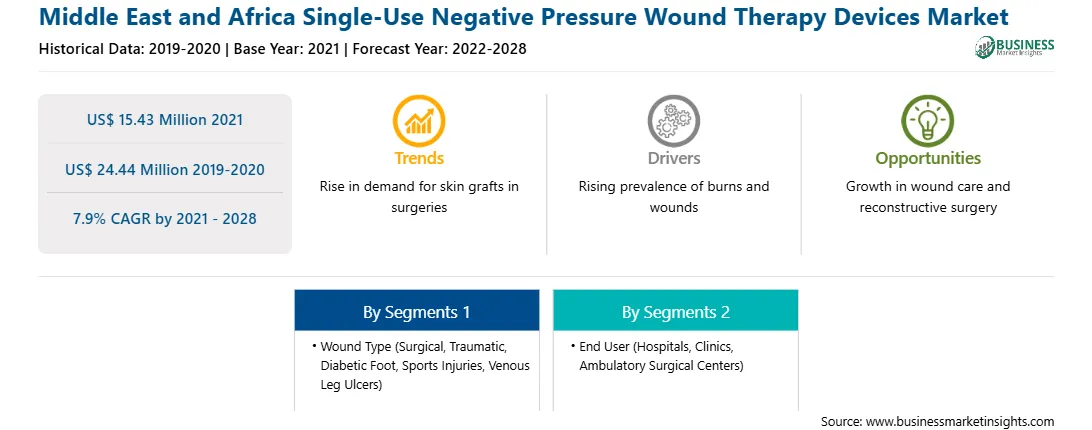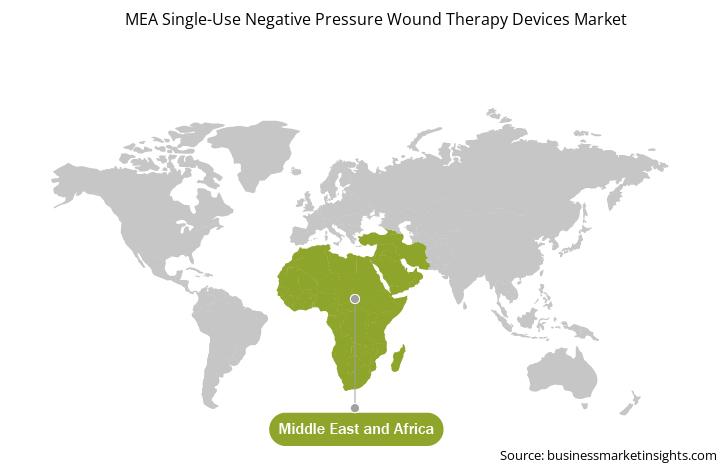Middle East and Africa Single-Use Negative Pressure Wound Therapy Devices Market
No. of Pages: 103 | Report Code: TIPRE00025225 | Category: Life Sciences
No. of Pages: 103 | Report Code: TIPRE00025225 | Category: Life Sciences
Negative pressure wound therapy (NPWT) is used for managing wide range of wound types such as traumatic, hard-to-heal, chronic wounds. It is also used to manage wounds that are covered with flaps or a skin graft. This therapy is transformed into a medical device such as a single-use NPWT device, and it is a small pocket-sized battery-operated device. As the name suggests, these are disposable and portable devices generally used for outpatient care.

Strategic insights for the Middle East and Africa Single-Use Negative Pressure Wound Therapy Devices provides data-driven analysis of the industry landscape, including current trends, key players, and regional nuances. These insights offer actionable recommendations, enabling readers to differentiate themselves from competitors by identifying untapped segments or developing unique value propositions. Leveraging data analytics, these insights help industry players anticipate the market shifts, whether investors, manufacturers, or other stakeholders. A future-oriented perspective is essential, helping stakeholders anticipate market shifts and position themselves for long-term success in this dynamic region. Ultimately, effective strategic insights empower readers to make informed decisions that drive profitability and achieve their business objectives within the market.

| Report Attribute | Details |
|---|---|
| Market size in 2021 | US$ 15.43 Million |
| Market Size by 2028 | US$ 24.44 Million |
| Global CAGR (2021 - 2028) | 7.9% |
| Historical Data | 2019-2020 |
| Forecast period | 2022-2028 |
| Segments Covered |
By Wound Type
|
| Regions and Countries Covered | Middle East and Africa
|
| Market leaders and key company profiles |
The geographic scope of the Middle East and Africa Single-Use Negative Pressure Wound Therapy Devices refers to the specific areas in which a business operates and competes. Understanding local distinctions, such as diverse consumer preferences (e.g., demand for specific plug types or battery backup durations), varying economic conditions, and regulatory environments, is crucial for tailoring strategies to specific markets. Businesses can expand their reach by identifying underserved areas or adapting their offerings to meet local demands. A clear market focus allows for more effective resource allocation, targeted marketing campaigns, and better positioning against local competitors, ultimately driving growth in those targeted areas.

The Middle East & Africa single-use negative pressure wound therapy market is expected to reach US$ 24.44 million by 2028 from US$ 15.43 million in 2021; it is estimated to grow at a CAGR of 7.9% from 2021 to 2028. The market’s growth is attributed to rising development in the global health sector and increasing cases of burn injuries. However, the market is expected to have a slow growth rate due to the lack of effective reimbursement policies for wound care.
The healthcare sector has undergone rapid transformations over several years, with the growing acceptance of advanced technologies. Technology-enabled care (TEC) solutions are being adopted in emerging economies with an increase in the need for better healthcare facilities. The surge in the aging population, incidence of chronic illnesses, and advancements in pediatric care are the primary factors driving the global healthcare sector. According to the World Bank data, healthcare expenditure accounts for ~9.94% of global GDP every year. Significant investments in R&D by various healthcare companies, governments, and research organizations and the ongoing improvements in reimbursement policies meant for various medical procedures are expected to fuel the growth of the healthcare sector in the coming years.
Moreover, the increasing number of effective regulations by government bodies is likely to result in better and reliable healthcare facilities, ensuring quality care and patient safety, and mitigating fraud and cyber-threats. Such developments in the healthcare sector worldwide are likely to provide significant growth opportunities for market players for advanced wound care devices, such as single-use negative pressure wound therapy devices. Also, single-use negative pressure wound therapy is among emerging technologies used for the management of burn-related wounds. Thus, the rise in burns and related injuries cases is driving the single-use negative pressure wound therapy devices market.
The recent COVID-19 pandemic is causing turbulence to the economies of the Middle East region. A sudden drop in domestic and external demand for goods and products and halted production due to labor shortage are significant impacts observed in the region. The spread of novel coronavirus in the region caused heavy burdens on healthcare professionals and impacted wound management. During the pandemic, conventional NPWT devices for wound management are facing more challenges, owing to the risk of cross-contamination through these devices. Hence, patients in the Middle East prefer disposable devices during the pandemic rather than using conventional NPWT devices. This will lead to the growth of the Middle East & Africa single-use negative pressure wound therapy device market.
Based on wound type, the Middle East & Africa single-use negative pressure wound therapy devices market was segmented into surgical, traumatic, diabetic foot, sports injuries, venous leg ulcers, and others. In 2020, the traumatic segment held the largest share of the market, and it is also expected to grow at the fastest rate during the coming years.
In terms of end user, the Middle East & Africa single-use negative pressure wound therapy devices market was segmented into hospitals, clinics, ambulatory surgical centers, and others. In 2020, the hospitals segment held the largest share of the market by end user. In addition, the demand for hospitals is expected to grow at the fastest rate during the coming years due to the availability of advanced techniques for single-use negative pressure wound therapy devices.
A few of the primary and secondary sources referred to while preparing the report on the Middle East and Africa single-use negative pressure wound therapy market are the National Center for Biotechnology Information (NCBI), Wound Healing Association of Southern Africa (WHASA) and International Federation of Diabetes (IDF).
The Middle East and Africa Single-Use Negative Pressure Wound Therapy Devices Market is valued at US$ 15.43 Million in 2021, it is projected to reach US$ 24.44 Million by 2028.
As per our report Middle East and Africa Single-Use Negative Pressure Wound Therapy Devices Market, the market size is valued at US$ 15.43 Million in 2021, projecting it to reach US$ 24.44 Million by 2028. This translates to a CAGR of approximately 7.9% during the forecast period.
The Middle East and Africa Single-Use Negative Pressure Wound Therapy Devices Market report typically cover these key segments-
The historic period, base year, and forecast period can vary slightly depending on the specific market research report. However, for the Middle East and Africa Single-Use Negative Pressure Wound Therapy Devices Market report:
The Middle East and Africa Single-Use Negative Pressure Wound Therapy Devices Market is populated by several key players, each contributing to its growth and innovation. Some of the major players include:
The Middle East and Africa Single-Use Negative Pressure Wound Therapy Devices Market report is valuable for diverse stakeholders, including:
Essentially, anyone involved in or considering involvement in the Middle East and Africa Single-Use Negative Pressure Wound Therapy Devices Market value chain can benefit from the information contained in a comprehensive market report.